Verge Review: Overview of the Anonymous Cryptocurrency
Verge (XVG) is a privacy focused cryptocurrency that has been through a great deal of ups and downs over the past 2 years.
While privacy was the main focus of the project, speed and transaction costs are also particular goals of the project. Verge also has quite a history and is one of those polarising projects that has a strong community following but many detractors and skeptics.
Is this skepticism warranted or is it merely "FUD"?
In this Verge review, I will attempt to answer that. I will also take an in-depth look at the use cases for XVG and its long term adoption potential.
Verge History
Verge was created back in 2014 and was originally called DogecoinDark. The rationale for creating the new blockchain and coin was that the Bitcoin blockchain was too transparent. The creator felt that by making wallet addresses freely open to public inspection people were at risk of government agencies or other users tracing a wallet’s history and learning the balance held.

The creator of DogecoinDark claimed that this made Bitcoin no better than traditional fiat currencies held in a bank account. And that prompted the creation of a fully private blockchain to protect financial privacy which would eventually be known as Verge.
Verge was started by an initially anonymous developer called "Sunerok". However, his identity was later revealed in order to be build more trust in the project (covered below).
Verge and Financial Privacy
Our traditional financial organizations such as banks, insurance companies, and other lenders regularly infringe on the financial privacy of citizens. They keep constant track of how much you have in your accounts, your incoming and outgoing funds, where you spend your money, what the money is spent on and so much more.
Increasingly there are people who believe that financial privacy should be a basic human right and that no one should have the ability to spy on your financial activities. No other person or entity should be able to track and store financial information about others.
Verge was created to solve these problems, allowing anyone on the planet to use its currency as an untraceable medium of exchange.
Verge is also impeccably democratic, with an open-source code base upon which anyone can suggest improvements. Those suggestions are voted on by the development team, and if a majority of Verge holders support the change it is implemented.
Verge Technical Details
One area in which Verge was intended to improve on Bitcoin is in transaction speed, and it has accomplished this. Bitcoin transactions take a minimum of 10 minutes, but Verge transactions are processed within 30 seconds.
Verge is also far more scalable when compared to Bitcoin. Currently, Bitcoin is capable of processing just 7 transactions per second, while Verge has the capability of processing 100 transactions per second. This scalability makes Verge more acceptable as a useful currency.
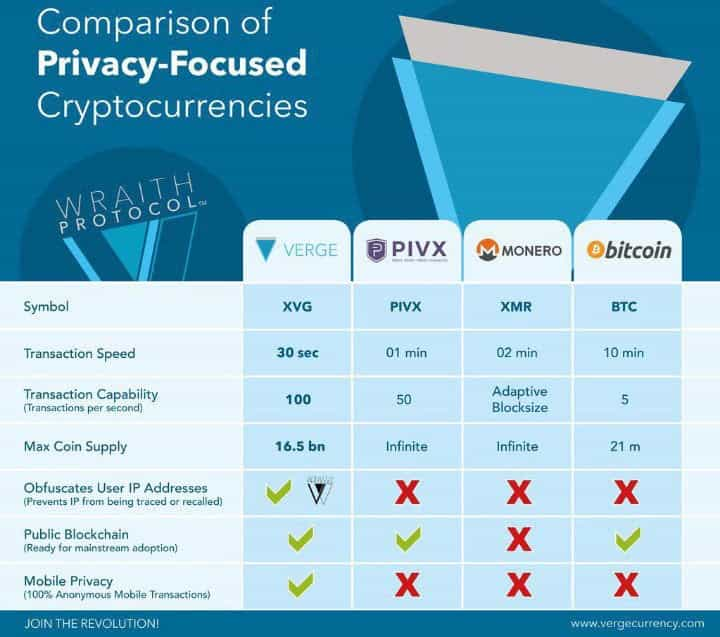
Vendors are able to receive payments quickly enough to make Verge useful as an everyday currency. Scalability also avoids the issue of miners being able to pick and choose which transactions to process, thus delaying some transactions by hours, or causing users to pay unreasonable transaction fees to push their transactions through.
All of this makes Verge more suitable as a transactional cryptocurrency, useful for everyday needs.
But there’s more. Verge also differs from Bitcoin (and most other cryptocurrencies) in its use of 5 mining algorithms. Unlike Bitcoin, which uses SHA-256 as its mining algorithm, Verge uses all of the following five mining algorithms:
- Blake2s
- Myr-groestl
- Lyra2rev2
- X17
- Scrypt
Using five different mining algorithms leads to increased decentralization for Verge and better security for the blockchain. Of course, there are risks that come with this as is illustrated in the miner attack we discuss below.
The way this increases centralization is by increasing the ways in which miners can use their computer hardware to mine successfully. By increasing the size of the mining pool, Verge also increases the decentralization of its network.
Verge Mining ⛏️: For those of you looking for the best pools to use, we have covered an extensive list of the best Verge Mining Pools.
We all know that centralisation of mining on the Bitcoin network is a concern. Powerful ASIC machines are deployed into massive mining farms and pools that centralize hash power.
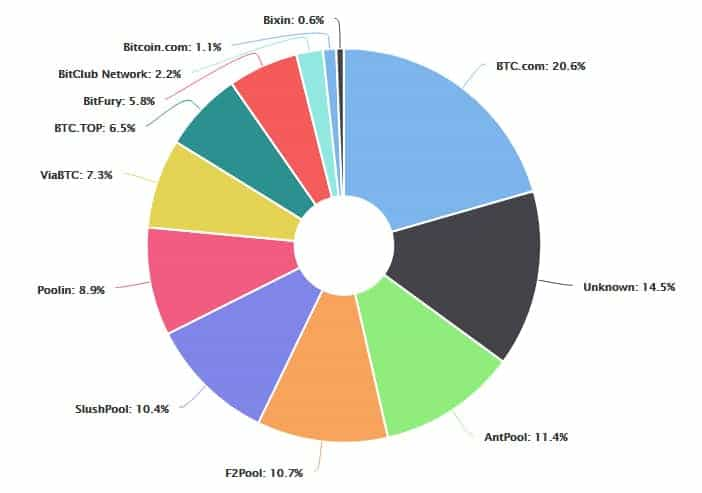
Just consider how Bitcoin is facing a huge problem due to ASIC mining. Because the hardware is expensive and most people can’t afford to buy it, let alone pay for the electricity and cooling to run it, ASIC mining has ensured centralization in the mining of Bitcoin.
Verge mining is carried out by all types of computer hardware, from ASICs to GPUs and CPUs, which ensures it will remain decentralized.
Now that you’re more familiar with the technical details behind Verge let’s have a look at its privacy features.
How Verge Ensures Financial Privacy
Because Verge was created as a solution to the lack of privacy in Bitcoin I’ll be making comparisons with Bitcoin as I explain how Verge improves privacy on the blockchain.
Remember that when you send a Bitcoin transaction your name isn’t transmitted, but your wallet address is. And along with your address, your internet service provider will also share your IP address with the blockchain, and this gives clues to your location.
While this might not cause an issue, and in most cases, it doesn’t, there is a possibility that someone could intercept this information, and link your Bitcoin address to your location. This presents the potential for a severe loss of privacy if a hacker can use this information to focus in on you individually.
Verge has improved on this by including 2 methods to hide your IP address, making your transactions untraceable.
The first method is known as TOR or the Onion network. TOR works by standing in between the Verge blockchain and your internet service provider and using its many servers to change you’re the IP address being sent from your internet provider to the Verge blockchain. This hides your location effectively, making it increasingly difficult for a bad actor to trace your location.
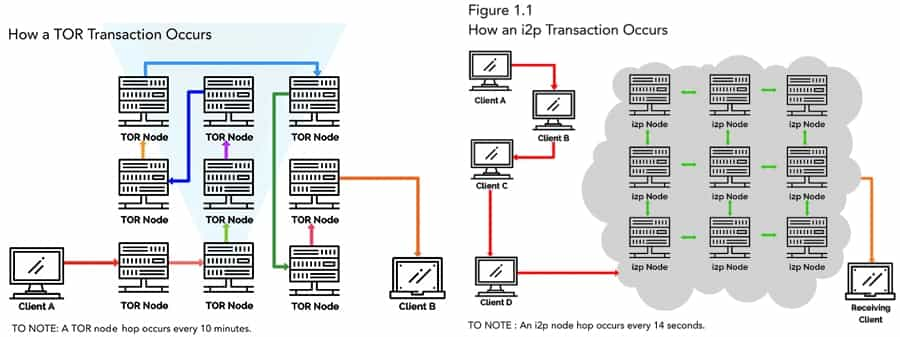
The second method is called I2P and while it is similar to TOR, it is also considered to be more efficient because it uses multiple paths rather than a single path like TOR. Using multiple paths allows I2P to break up your transaction into several parts, making it much more difficult to trace a transaction since only part of the information is accessible from any one path.
Verge released the Wraith Protocol on January 1, 2018, which allows Verge users to choose between sending their transactions in an open environment, or behind the veil of the closed doors created by the wraith protocol.
The wraith protocol works by Verge running both public and private ledger. Users can decide whether they want to transact transparently on the public network, or in stealth mode on the private network. Also called stealth addresses, Verge is the only platform to offer this feature.
The wraith protocol doesn’t hide the fact that the transaction occurred. The transaction can be seen on the public blockchain ledger, but the sender and recipient cannot be seen with the wraith protocol being used.
The Verge Team
As mentioned earlier, Verge was created by an anonymous individual known only as Sonerok. Well, he isn’t completely anonymous any longer, and it is now known his name is Justin and he lives in Florida.
He released his identity because cryptocurrency projects with anonymous development teams aren’t trusted within the cryptocurrency community. He remains the leader of Verge, along with Marvin, or “Marpme”, a software engineer from Berlin. The core development team has six additional members, who span the globe from India to Russia and Australia to Switzerland.

Verge had no ICO and no pre-mine of the XVG currency, therefore no cash grab involved. It remains completely open-source and all the contributors are unpaid volunteers, even the core Verge Team.
Verge Community
This has to be one of the strong points of the Verge project. Verge is well known for having a very active, passionate and engaged community.
"Vergefam" is the moniker adopted by the group.
A strong community is great for the adoption of a cryptocurrency as it leads to more awareness from those outside of the project. It could also spur more merchant adoption and partnerships.
In terms of the Verge following, they have a pretty large Telegram group with over 19k members. I decided to jump into the Telegram to get a sense of the discussions that were taking place.

As you can see, it is currently comprised mostly of memes and other banter. There was unfortunately not that much technical discussion amoung the members.
Over on their social media accounts, Verge has a pretty sizable following on Twitter with over 300k followers. This is more than we have seen at other projects and it all appears to be organic.
On their Twitter, they regularly keep their community updated with the latest to come out of the project. This includes new features, partnerships or community engagements (of which there are quite a few)
Moving on, they also have a Reddit account as well as a Facebook, Discord and YouTube. I jumped into their Reddit and they have about 53k members. There is less discussion here than there is in the Telegram.
In terms of the community engagements, Verge has held quite a number of them around the world. For example, they held their most recent one in Rotterdam which seemed to be well attended.
Partnerships
Verge has taken the view that adoption by merchants is key to growing out the broader ecosystem. Hence, they have been quite active in forming a number of different partnerships.
Perhaps one of the most notable was the partnership that they formed with Mindgeek. For those that do not know, MindGeek operates the largest Porn sites in the world (PornHub, Brazzers etc.).
The partnership would see Pornhub offering verge as a payment method on their websites. This was indeed quite a fitting partnership given that Verge is a privacy coin and people can purchase Porn anonymously.
Of course, this was just the most notable of the partnerships. The Verge community has been quite active engaging a number of online merchants and encouraging them to accept Verge.
There is quite an impressive selection of vendors including gyms, vape stores, hosting, vpn providers and even cleaning agents. You can find out more about these on the Verge Website.
Mining Attack
It has not been all plain sailing for Verge over the past few years. One of the most noticeable events that overshadowed the project was a miner network attack that happened in April of 2018.
In this attack, a malicious miner was able to exploit a loophole in the mining algorithms whereby they would "Spoof" timestamps in the blocks. This would then allow the attacker to mine blocks with really low levels of difficulty.
The Verge devs scrambled to try and find a fix to the exploit and they implemented a minor patch. However, the attacker was able to find a hack around the patch and exploit the code again.
When all was said and done, the attacker was able to mine 35m XVG which was about $1.7m at the time.
The Verge developers were eventually able to release an update that closed the loophole. Since then, there have not been any more miner exploits on the chain.
Whether it will stand the test of time is hard to tell. Verge does use a more complicated mining algorithm and mining power can easily be rented these days in order to carry out attacks.
Verge Development
It can sometimes be hard to determine exactly how much work is being done on a project. There are many moving parts and some of the work can sometimes be taking place behind the scenes.
However, there is a quick and easy rule of thumb that I like to use and that is their public code commits. This can give me a reasonable idea of how much work a project has been doing on their protocol.
Hence, I decided to head on over to the Verge GitHub to get a look for myself. In the below we the commits from the top 3 most active repositories.
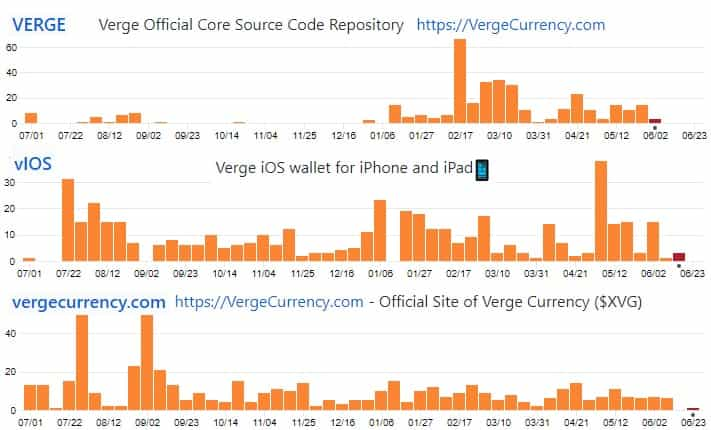
As you can see there has been quite a bit of activity in these repos over the past year. It is also worth pointing out that there are an additional 49 repos with varying degrees of activity.
This is more than the average level of activity that I have seen on other projects that are at similar stages in their life. You can even compare this developer activity to other crypto projects on coincodecap. Here, Verge is positioned at 68.
Perhpas all of this development activity will make sense when viewed in conjuction with their public roadmap.
Verge Roadmap
You can view the Verge Roadmap over here. Below are some of the most important technological updates that have taken place over the past year:
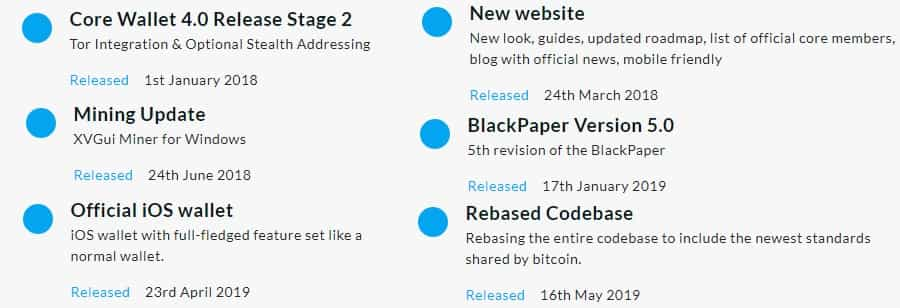
Some of the most notable achievements for the devs over the past year was their release of their Core Wallet 4.0 with Tor integration as well as their official iOS wallet.
However, what is most exciting is what they are currently working on. Below are some of these updates:
- Desktop Wallet: They are working on an Electron based wallet that will have better performance than the current one and a more intuitive UI. This is currently 85% complete.
- RingCT Integration: Ring Confidential transactions are privacy enhancing features that are currently used with great effectiveness in Monero. The Verge devs say that they are about 45% complete.
- RSK Smart Contracts: The devs say that they are busy looking into the integration of RSK smart contracts. Currently, it looks more like research at this stage as they are only 25% complete there.
- Android Wallet: Fresh off the release of their iOS wallet, the devs want to spruce up their Android wallet. They want to redesign the user interface so that it will match the new corporate identity. This is still in the early stages and is about 30% complete.
Unfortunately, no timelines were given for the release of these updates. Therefore, I will keep a keen eye on their GitHub as well as their other social media channels for any updates on these milestones.
XVG Performance
The currency associated with the Verge blockchain has the ticker symbol XVG. Unlike Bitcoin’s limited maximum supply of 21 million BTC, Verge created a maximum supply of 16.5 billion XVG.
This has had the fairly predictable and expected effect of keeping the price of XVG far lower than BTC. One other notable aspect of XVG is that it was created without an ICO or pre-mine, so there was no cash grab motivation in the creation of Verge and XVG.
Verge also may be one of the most profitable coins for early investors because it didn’t have an ICO or pre-mine. After its creation in 2014 (as DogecoinDark), XVG hit an all-time low of just $0.000002 each in February 2015. That means in 2014 a $10 investment would have bought 5,000,000 XVG tokens.
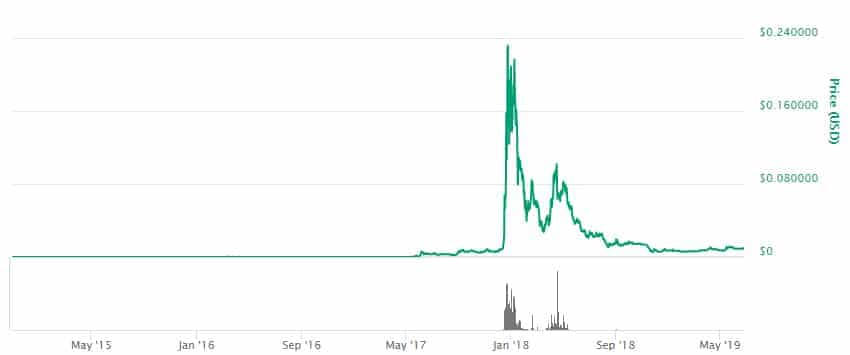
And that would have been $10 well spent, since XVG hit an all-time high of $0.300588 in December 2017. Anyone smart, or lucky, enough to buy $10 worth of XVG in February 2015 could have sold it for just over $1.5 million in December 2017. And just think if it would have been a $100 purchase of XVG in 2015.
While it’s too late to buy XVG at just $0.000002 each, you can still buy it for under $0.01 each as of June 2019.
Buying & Storing XVG
If you are looking to trade XVG, there are a number of exchanges that it is currently listed on. It is trading on Binance, Upbit, Huobi and Bittrex among others. You can also use a non-custodial exchange such as Changelly for example.
When it comes to trading volume, over 60% currently being traded on Binance with about 10% being traded on Bittrex. The turnover on Binance is quite sizable which implies that there is a decent level of liquidity for the tokens.

Given this liquidity, large block executions of XVG won't lead to much slippage. Having said that, it is quite susceptible to news flow and as such is more volatile than coins of similar market cap.
Once you have your XVG, you will want to move your coins off the exchange as this is the most prudent thing to do. We are all aware of the risks that come from storing coins on centralized exchanges.
The team at Verge have created secure and private desktop wallets for Windows, OSX, and Linux as well as mobile versions for Android and iOS. And while there isn’t any hardware wallet support for Verge, you can create a paper wallet.
If you are looking for a more extensive overview of XVG wallets, we have covered it in our list of best Verge wallets.
Conclusion
Verge has indeed had quite a rocky ride. At one point it was in the top 40 cryptocurrencies in the world, and even though it has been punished by the 2018 crypto bear market, it remains in the top 100 of all cryptocurrencies comfortably, sitting at the #66 spot as of June 2019.
I like the fact that the project was launched without a pre-mine or any ICO. Moreover, there is a large community of adherents that are pushing adoption of the privacy coin. The numerous partnerships that Verge has entered into are also likely to increase awareness and use cases.
Of course, the miner attack of 2018 was a cause for concern. This illustrates the risk that new cryptocurrencies face from sophisticated attackers who are able to rent hash-power to attack a chain.
Moreover, Verge does face stiff competition from larger and more entrenched rivals. These include the likes of Monero and Zcash in the privacy coin front as well as Litecoin or Bitcoin Cash on the payments front.
Either way, the cryptocurrency space is still extremely young...
So we will all have to wait and see if Verge eventually grows to become the top payments privacy coin, or if it drifts to the wayside.
Disclaimer: These are the writer's opinions and should not be considered investment advice. Readers should do their own research.
Disclaimer: These are the writer’s opinions and should not be considered investment advice. Readers should do their own research.
